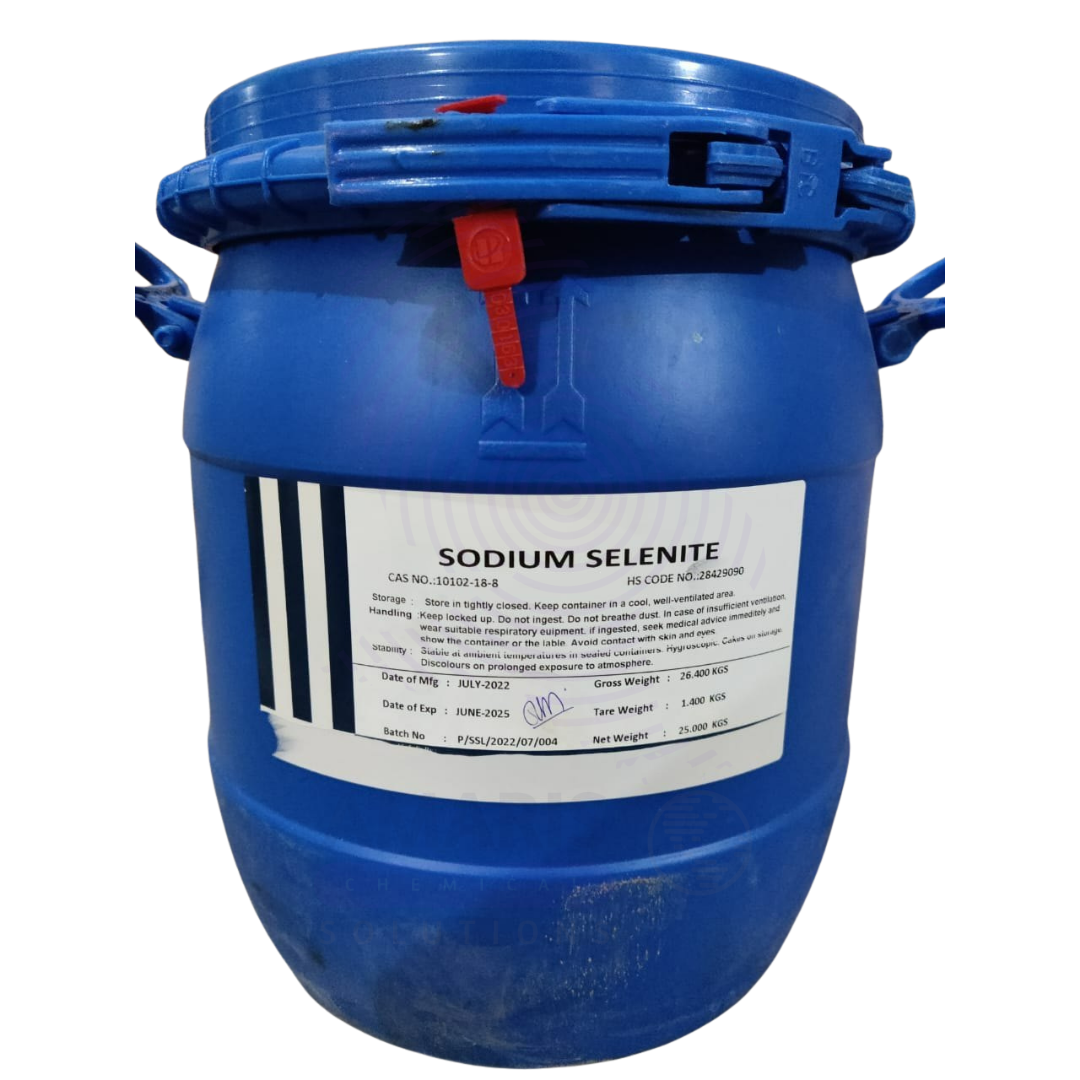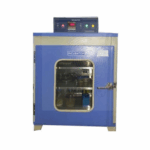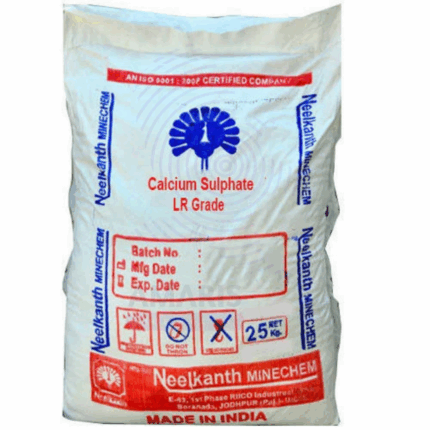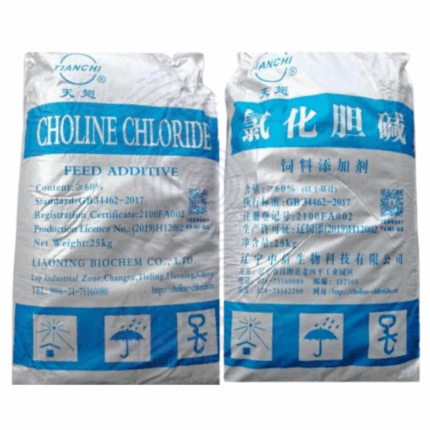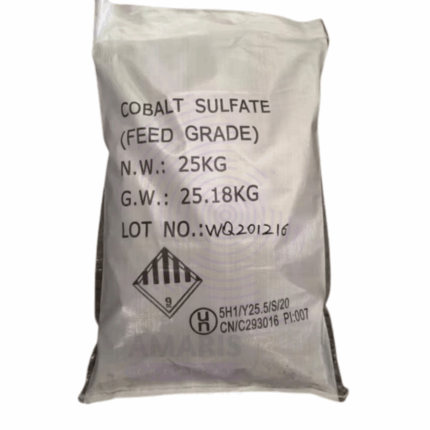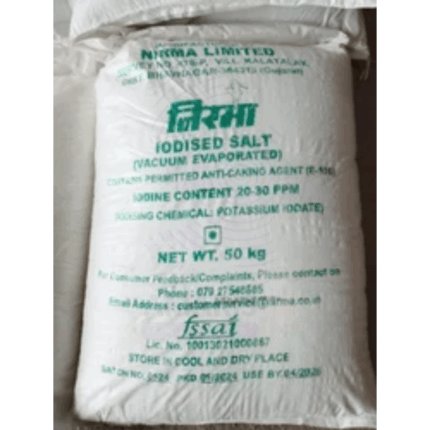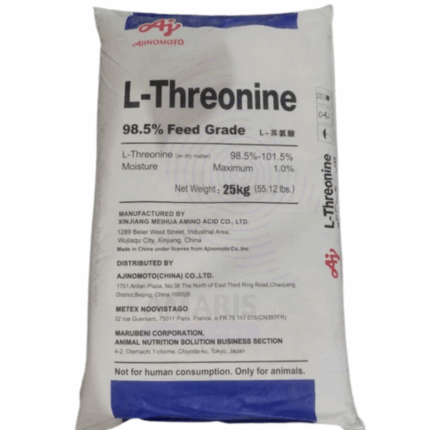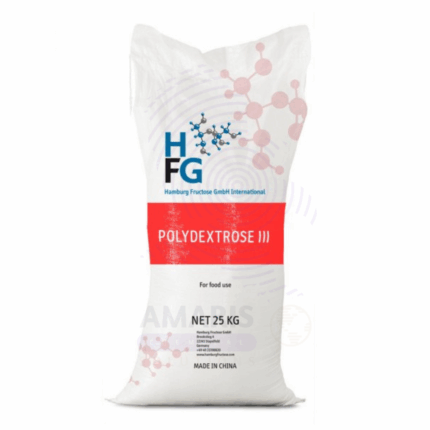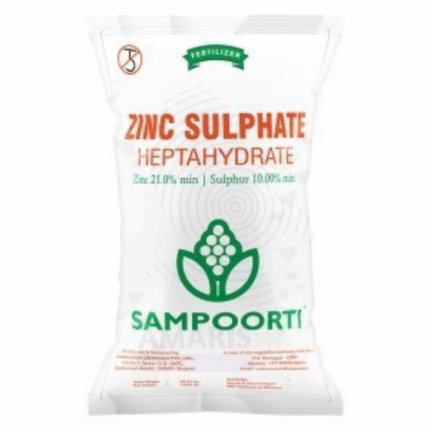Back to products


Polyglyceryl Extra Pure
$ 18.20 Original price was: $ 18.20.$ 18.09Current price is: $ 18.09.
Sodium Selenite
Whatsapp Order
Sodium Selenite is an inorganic selenium compound with the formula Na₂SeO₃. In its commercial 45% concentration, it is typically supplied as a colorless to slightly yellow aqueous solution or as a crystalline solid with 45% selenium content. It is primarily used as a micronutrient additive in animal nutrition, a reagent in the pharmaceutical and glass industries, and in various research applications. Highly bioavailable, it serves as a key selenium source where controlled selenium supplementation is critical. This 25kg product offers precise dosing, stability, and ease of handling in industrial and agricultural settings.
Description
Table of Contents
Toggle
Sodium Selenite
Primary Uses
- Animal Nutrition
- Feed Additive for Livestock: Provides essential selenium in poultry, swine, and cattle feed formulations.
- Pet Food Fortification: Supplies trace selenium in dog and cat food.
- Aquaculture Feed: Maintains optimal selenium levels in fish and shrimp diets.
- Premix Manufacturing: Used in vitamin-mineral premixes for commercial feed production.
- Pharmaceutical & Nutraceutical Industry
- Dietary Supplements: Source of selenium in tablets, capsules, and liquid formulations.
- Parenteral Nutrition: Occasionally used in injectable selenium preparations under medical supervision.
- Topical Formulations (Antifungal/Skin health): Included in certain dermatological preparations for its antimicrobial properties.
- Glass & Ceramics Industry
- Glass Manufacturing: Acts as a decolorizing agent to neutralize green tints caused by iron.
- Red-Colored Glass Production: Imparts pink or red coloration in specialty glass and enamels.
- Chemical & Industrial Applications
- Metal Alloy Additive: Used in specialty steels and brasses for improved machinability.
- Electronics & Semiconductors: Occasionally used in selenium-containing compounds for photovoltaic or rectifier applications.
- Pigments & Dyes: Trace amounts used in certain inorganic pigment formulations.
Secondary Uses
- Water Treatment & Environmental Applications
- Nutrient Additive in Bioremediation: Supports microbial activity in selenium-deficient remediation environments.
- Trace Element Balancing in Hydroponics: Occasionally used to supplement selenium in nutrient solutions.
- Laboratory & Research
- Cell Culture & Biotech Research: Essential trace element in media for mammalian and microbial cultures.
- Analytical Chemistry Reagent: Employed in certain redox titrations or as a selenium standard.
- Toxicology & Nutrition Studies: Used in controlled studies on selenium metabolism and deficiency.
- Agriculture (Plant Nutrition)
- Soil Fertilizer (Micro-dose Application): In selenium-deficient regions, applied in trace amounts to increase plant selenium uptake.
- Foliar Application (Very limited): Applied in diluted form to crops to enrich selenium content for human/animal consumption.
- Veterinary & Animal Health
- Injectable Selenium-Vitamin E Therapy: Used under veterinary supervision for selenium-responsive disorders (e.g., white muscle disease).
- Mineral Licks & Blocks: Incorporated into solid supplements for grazing animals.
KEY PRODUCT FEATURES
1. Basic Identification Attributes
- Chemical Name (IUPAC): Disodium selenite
- Common/Trade Name: Sodium Selenite
- CAS Number: 10102-18-8
- HS Code: 2842.90.00
- Synonyms: Disodium selenite, Sodium salt of selenious acid
2. Physical & Chemical Properties
- Physical State: Typically an aqueous solution or crystalline powder
- Color & Odor: Colorless to pale yellow; odorless
- Concentration: 45% active Sodium Selenite by weight (in solution)
- Solubility: Freely soluble in water
- Density (solution): ~1.45–1.50 g/cm³
- pH (solution): 8.0–9.5
- Molecular Weight: 172.94 g/mol (anhydrous Na₂SeO₃)
3. Safety & Hazard Attributes
- GHS Classification: Acute Toxicity Oral (Category 2), Aquatic Acute (Category 1), Aquatic Chronic (Category 1)
- Toxicity: LD₅₀ (oral, rat) ≈ 3.9 mg/kg
- Exposure Limits: OSHA PEL: 0.2 mg Se/m³ (as selenium)
- Carcinogenicity: Not classifiable (IARC Group 3); regulated due to narrow margin between essentiality and toxicity
4. Storage & Handling Attributes
- Storage Conditions: Store in a cool, dry, well-ventilated area; keep container tightly closed
- Container Type: 25kg HDPE drums, IBCs, or lined steel drums for bulk liquid
- Shelf Life: 12–24 months under recommended conditions
- Handling Precautions: Avoid skin and eye contact; minimize aerosol or mist formation
5. Regulatory & Compliance Attributes
- REACH Registered
- Complies with:
- EU Feed Additive Register (EC No. 1831/2003)
- US FDA regulations (21 CFR 573.920 – Selenium in animal feeds)
- USP Grade Available (for pharma/nutraceutical use)
- UN Number: Not classified as a dangerous good for transport in solution
- TSCA Listed
6. Environmental & Health Impact
- Biodegradability: Inorganic compound; not biodegradable
- Ecotoxicity: Highly toxic to aquatic life
- Bioaccumulation: Potential in aquatic organisms; requires controlled disposal
- Soil Impact: Persistent in soil if not managed; risk of phytotoxicity at high concentrations
SAFETY HANDLING PRECAUTIONS
Safety Handling Precautions
- PPE Required: Chemical-resistant gloves, safety goggles, lab coat, and dust or mist mask (as applicable)
- Handling Guidelines: Use only in well-ventilated areas; avoid spills into environment
- Storage Measures: Keep away from strong acids, oxidizers, and incompatible metals
First Aid Measures
- Inhalation: Move to fresh air immediately; seek medical attention if symptoms occur
- Skin Contact: Rinse with water and remove contaminated clothing
- Eye Contact: Flush eyes with water for at least 15 minutes; seek medical advice
- Ingestion: Rinse mouth; do NOT induce vomiting; seek urgent medical attention
Firefighting Measures
- Fire Hazards: Not flammable; may decompose at high temperatures producing toxic selenium fumes
- Extinguishing Media: Water spray, CO₂, dry chemical
- Hazardous Combustion Products: Selenium oxides, toxic fumes
Related products
Calcium Sulphate
Calcium Sulphate is an inorganic compound composed of calcium, sulfur, and oxygen, commonly found in two forms: dihydrate (gypsum, CaSO4·2H2O) and anhydrous (CaSO4). It appears as a white or off-white crystalline powder or granules with low solubility in water. Calcium Sulphate is widely used in construction, agriculture, pharmaceuticals, food industry, and various industrial applications. It acts as a filler, hardening agent, and drying agent due to its physical and chemical properties. The dihydrate form (gypsum) is notable for use in plaster and cement, while the anhydrous form is often used as a drying agent and in refractory materials.
Choline Chloride Powder
Choline Chloride Powder is a white to off-white crystalline powder containing 60% choline chloride, a quaternary ammonium salt essential as a nutrient in animal and poultry feed. It serves as a vital source of choline, an important component in fat metabolism, liver function, and cell membrane integrity. Produced through chemical synthesis, this powder form is highly soluble in water, making it easy to incorporate into feed premixes and supplements. Choline chloride is widely used in the agriculture industry to prevent choline deficiency, enhance growth performance, and improve overall health in livestock. Beyond animal nutrition, it finds applications in chemical manufacturing and pharmaceuticals.
Cobalt Sulphate Feed Grade
Cobalt Sulphate Feed Grade is a cobalt salt of sulfuric acid, typically appearing as a pink to reddish crystalline powder or granules. It is specifically manufactured and purified for use as a trace mineral supplement in animal nutrition. Cobalt is an essential trace element required in small amounts for the synthesis of vitamin B12 (cobalamin) in ruminants, playing a vital role in maintaining proper metabolism, growth, and overall health. Feed grade cobalt sulfate ensures safe, bioavailable cobalt supply to livestock such as cattle, sheep, goats, and poultry, supporting rumen microbial activity, appetite, and red blood cell production.
Iodised Salt
Iodised Salt is table salt (sodium chloride) fortified with a small, controlled amount of iodine, typically in the form of potassium iodate or potassium iodide. It appears as fine white crystalline granules, odorless, and with a characteristic salty taste. The addition of iodine helps prevent iodine deficiency disorders (IDD) such as goiter, mental impairment, and developmental abnormalities. Iodised Salt is widely used in households, food processing, and animal nutrition to ensure adequate dietary iodine intake.
L-Threonine Feed Grade
L-Threonine Feed Grade is a high-purity essential amino acid used primarily as a nutritional supplement in animal feed. It appears as a white crystalline powder and is vital for protein synthesis, growth, and overall health in livestock. This feed-grade form of L-Threonine helps balance amino acid profiles in animal diets, especially in monogastric animals like poultry and swine, improving feed efficiency and production performance.
Magnesium Sulphate (Epsom Salt)
Magnesium Sulphate Epsom Salt, commonly known as Epsom Salt, is an inorganic salt composed of magnesium, sulfur, and oxygen with the formula MgSO₄. It typically appears as colorless or white crystalline granules and is highly soluble in water. In its heptahydrate form (MgSO₄·7H₂O), it is widely used in agriculture, pharmaceuticals, food, and industrial applications. Epsom Salt is valued for its muscle relaxant, laxative, and magnesium supplementation properties, as well as for its role in improving soil fertility and plant growth.
Polydextrose
Polydextrose is a synthetic, highly branched polymer of glucose used primarily as a soluble dietary fiber, bulking agent, and low-calorie sweetener. It is produced through the polycondensation of dextrose with sorbitol and citric acid. Polydextrose offers numerous health and functional benefits, such as improving texture, replacing sugar or fat, and supporting digestive health. It is extensively used in food, beverages, pharmaceuticals, and nutraceuticals for its fiber enrichment properties and technological versatility.
Zinc Sulphate Heptahydrate
Zinc Sulphate Heptahydrate (ZnSO₄·7H₂O) is a white, crystalline, water-soluble compound commonly used as a dietary supplement to treat zinc deficiency. It serves as a key ingredient in fertilizers, animal feeds, and industrial applications like water treatment and dyeing. The heptahydrate form contains seven water molecules, making it highly soluble and effective for various agricultural, medical, and chemical uses.


 Preservatives(food)
Preservatives(food) Flavor Enhancers
Flavor Enhancers Acidulants
Acidulants Sweeteners
Sweeteners Antioxidants
Antioxidants Colorants(food)
Colorants(food) Nutraceutical Ingredients (food)
Nutraceutical Ingredients (food) Nutrient Supplements
Nutrient Supplements Emulsifiers
Emulsifiers
 Collectors
Collectors Dust Suppressants
Dust Suppressants Explosives and Blasting Agents
Explosives and Blasting Agents Flocculants and Coagulants
Flocculants and Coagulants Frothers
Frothers Leaching Agents
Leaching Agents pH Modifiers
pH Modifiers Precious Metal Extraction Agents
Precious Metal Extraction Agents
 Antioxidants(plastic)
Antioxidants(plastic) Colorants (Pigments, Dyes)
Colorants (Pigments, Dyes) Fillers and Reinforcements
Fillers and Reinforcements Flame Retardants
Flame Retardants Monomers
Monomers Plasticizers
Plasticizers Polymerization Initiators
Polymerization Initiators Stabilizers (UV, Heat)
Stabilizers (UV, Heat)
 Antifoaming Agents
Antifoaming Agents Chelating Agents
Chelating Agents Coagulants and Flocculants
Coagulants and Flocculants Corrosion Inhibitors
Corrosion Inhibitors Disinfectants and Biocides
Disinfectants and Biocides Oxidizing Agents
Oxidizing Agents pH Adjusters
pH Adjusters Scale Inhibitors( water)
Scale Inhibitors( water)
 Antioxidants(cosmetic)
Antioxidants(cosmetic) Emollients
Emollients Fragrances and Essential Oils
Fragrances and Essential Oils Humectants
Humectants Preservatives
Preservatives Surfactants(cosmetic)
Surfactants(cosmetic) Thickeners
Thickeners UV Filters
UV Filters
 Fertilizers
Fertilizers Soil Conditioners
Soil Conditioners Plant Growth Regulators
Plant Growth Regulators Animal Feed Additives
Animal Feed Additives Biostimulants
Biostimulants Pesticides (Herbicides, Insecticides, Fungicides)
Pesticides (Herbicides, Insecticides, Fungicides)
 Active Pharmaceutical Ingredients (APIs)
Active Pharmaceutical Ingredients (APIs) Excipients
Excipients Solvents(pharmaceutical)
Solvents(pharmaceutical) Antibiotics
Antibiotics Antiseptics and Disinfectants
Antiseptics and Disinfectants Vaccine Adjuvants
Vaccine Adjuvants Nutraceutical Ingredients (pharmaceutical)
Nutraceutical Ingredients (pharmaceutical) Analgesics & Antipyretics
Analgesics & Antipyretics
 Analytical Reagents
Analytical Reagents Solvents(lab)
Solvents(lab) Chromatography Chemicals
Chromatography Chemicals Spectroscopy Reagents
Spectroscopy Reagents microbiology-and-cell-culture-reagents
microbiology-and-cell-culture-reagents Molecular Biology Reagents
Molecular Biology Reagents Biochemical Reagents
Biochemical Reagents Inorganic and Organic Standards
Inorganic and Organic Standards Laboratory Safety Chemicals
Laboratory Safety Chemicals Specialty Laboratory Chemicals(Special Laboratory Equipment)
Specialty Laboratory Chemicals(Special Laboratory Equipment)
 Demulsifiers
Demulsifiers Hydraulic Fracturing Fluids
Hydraulic Fracturing Fluids Scale Inhibitors(oil)
Scale Inhibitors(oil) Surfactants(oil)
Surfactants(oil) Drilling Fluids
Drilling Fluids
 Dyes and Pigments
Dyes and Pigments Bleaching Agents
Bleaching Agents Softening Agents
Softening Agents Finishing Agents
Finishing Agents Antistatic Agents
Antistatic Agents
 Admixtures
Admixtures Waterproofing Agents
Waterproofing Agents Sealants and Adhesives
Sealants and Adhesives Curing Compounds
Curing Compounds Concrete Repair Chemicals
Concrete Repair Chemicals Anti-Corrosion Coatings
Anti-Corrosion Coatings
 Surfactants(cleaning)
Surfactants(cleaning) Builders
Builders Enzymes
Enzymes Solvents (Cleaning)
Solvents (Cleaning) Fragrances
Fragrances
 Electronic Chemicals
Electronic Chemicals Catalysts
Catalysts Lubricants
Lubricants Photographic Chemicals
Photographic Chemicals Refrigerants
Refrigerants Automotive chemicals
Automotive chemicals Pyrotechnic Chemicals
Pyrotechnic Chemicals
 Biodegradable Surfactants
Biodegradable Surfactants Bio-based Solvents
Bio-based Solvents Renewable Polymers
Renewable Polymers Carbon Capture Chemicals
Carbon Capture Chemicals Wastewater Treatment Chemicals
Wastewater Treatment Chemicals
 Pigments
Pigments Solvents(paint)
Solvents(paint) Specialty Coatings
Specialty Coatings Binders/Resins
Binders/Resins Additives
Additives Driers
Driers Anti-Corrosion Agents
Anti-Corrosion Agents Functional Coatings
Functional Coatings Application-Specific Coatings
Application-Specific Coatings
 Fresh Herbs
Fresh Herbs Ground Spices
Ground Spices Whole Spices
Whole Spices Spice Blends
Spice Blends Dried Herbs
Dried Herbs
 Leavening Agents
Leavening Agents Dough Conditioners
Dough Conditioners Flour Treatments
Flour Treatments Fat Replacers
Fat Replacers Decoratives
Decoratives Preservatives(baking)
Preservatives(baking)
 Plasticizers & Softeners
Plasticizers & Softeners Reinforcing Agents
Reinforcing Agents Adhesion Promoters
Adhesion Promoters Vulcanizing Agents
Vulcanizing Agents Antidegradants
Antidegradants Blowing Agents
Blowing Agents Fillers & Extenders
Fillers & Extenders Accelerators & Retarders
Accelerators & Retarders